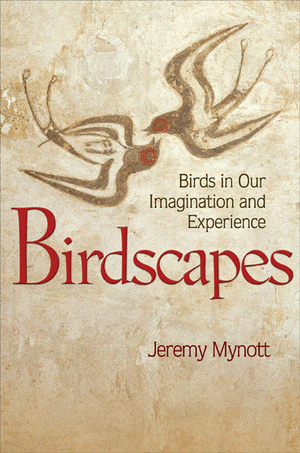
Birdscapes: Birds in Our Imagination and Experience
by Jeremy Mynott
Robins are a well-liked bird, as Jeremy Mynott acknowledges: poets pen odes to them, their name graces folk heroes and British soccer teams, their red breasts and plump, jolly shapes make annual appearances on Christmas cards.
But the glossy image doesn’t necessarily match the animal. Mynott goes on to demolish the beloved stereotype. Robins are, he writes, “extremely aggressive and are ready to fight to the death other robins,” they attack anything red, they sing to scare rivals rather than to please others, and their kindness to humans is “cupboard love.” And as for the warm red breast, Mynott says, in folklore the stain symbolizes “blood, sacrifice, and death.”
He follows this, endearingly, with an apology: “I’m sorry about all this. I like robins too, but in a different way.” The passage as a whole is indicative of Mynott’s work in Birdscapes: to be at once authoritative and personal, expansive and intimate, expertly detailed. He examines birds broadly, in scientific and cultural contexts, as animals and as symbols.
A lifelong birdwatcher, Mynott takes on the manifold relationship between human and bird. We are naturalists who take pleasure in perceiving physical characteristics and habits of the creatures. We are birdwatchers who collect sightings and experiences – and Mynott has many, in far-flung regions, with which he begins each of his chapters. We are fortunetellers who seek omens in bird flights. We are poets; Mynott liberally quotes John Clare and Henry David Thoreau and Ted Hughes alongside birders’ guides and journals. We name, designate and mythologize birds, in cultures around the world and across time. Despite birders’ advice against it, we anthropomorphize them. And in any case, we also apply avian metaphors to ourselves (Mynott provides a list that includes swanning around, gullible, sniping, cuckold, grouse and jinx).
Mynott deconstructs each of these relationships. Discussing the purely scientific approach to birds and birdwatching, Mynott praises the precision, effectiveness, and progressiveness of scientific language while noting that “perfect accuracy is achieved only at the cost of total incomprehension,” and that “we need to be open to the larger imaginative frameworks of art and literature.” He allows that discerning minor characteristics, list-making and collecting are pleasures in themselves, as old as Adam (and to show his range, he also quotes Jean Baudrillard: “Any collection comprises a succession of items, but the last in the set is the person of the collector”). He forgives the relativism and imprecision of naming favorite or rare birds, or even naming birds at all – English-speaking countries don’t agree on what to call some common creatures.
Throughout, he pursues deeper, sometimes even philosophical questions and offers his musings. Do bird names have any real significance or are they, like John Stuart Mill said of names, “an unmeaning mark”? What does it mean to be natural, he asks, when species die off or expand or adapt, and conservation and development over time transform nature and create new norms? Why do we privilege sight over sound in our experience of animals? What does it mean for animals to have charisma or beauty – is it grace and cuteness, or aesthetic elements that bear little evolutionary advantage, like the peacock tail? And does the beauty come from the bird, or from the human reaction alone, or from some alchemical combination of the two?
Mynott maintains the quality with which he begins his book throughout: a sense of wonder. As a birder he seeks “an unrepeatable instant,” an ineffable, particular and personal experience of seeing a bird. And like everyone else, birders or not, he appreciates birds’ similarities to humans: they sing, they gather in groups, they walk on two legs. But as Mynott knows, the differences are what drive our sometimes obsessive, sometimes casual, but ongoing pursuit of birds: they are quick and free, they have enviably keen senses, they fly (mostly). They are of the air more than the earth, demanding, it seems, to be both exalted and captured. And we comply, if only metaphorically, in our lists and our books.
Excerpt: “The peregrine is the prince of falcons, reputedly the fastest bird in the world when plunging vertically downwards in its killing stoop, the bird of choice for falconers and kings. Vultures are as large as or larger even than eagles and different vulture species have been revered in many cultures: this too was a bird of augury for the Greeks and Romans, not always distinguished from the eagle; it was the bird of Mut in Egyptian mythology, associated particularly with women; it appears in Pueblo Indian lore and the Mayan calendar; and it is the principle agent in contemporary Parsee rituals of ‘sky burial’ in India. The lammergeier is also a vulture, the bearded vulture, known in Greek as the ‘bone-breaker’ and ‘tortoise-eater’ from its habit of dropping bones from a great height to smash them open and expose the marrow. Hence the old story that the bird was supposedly responsible for the death of the Greek dramatist Aeschylus, when it dropped a tortoise onto his bald head, mistaking it for a bare slab of rock.”
Further Reading: The Life of the Skies: Birding at the End of Nature and The Wisdom of Birds: An Illustrated History of Ornithology




Send A Letter To the Editors